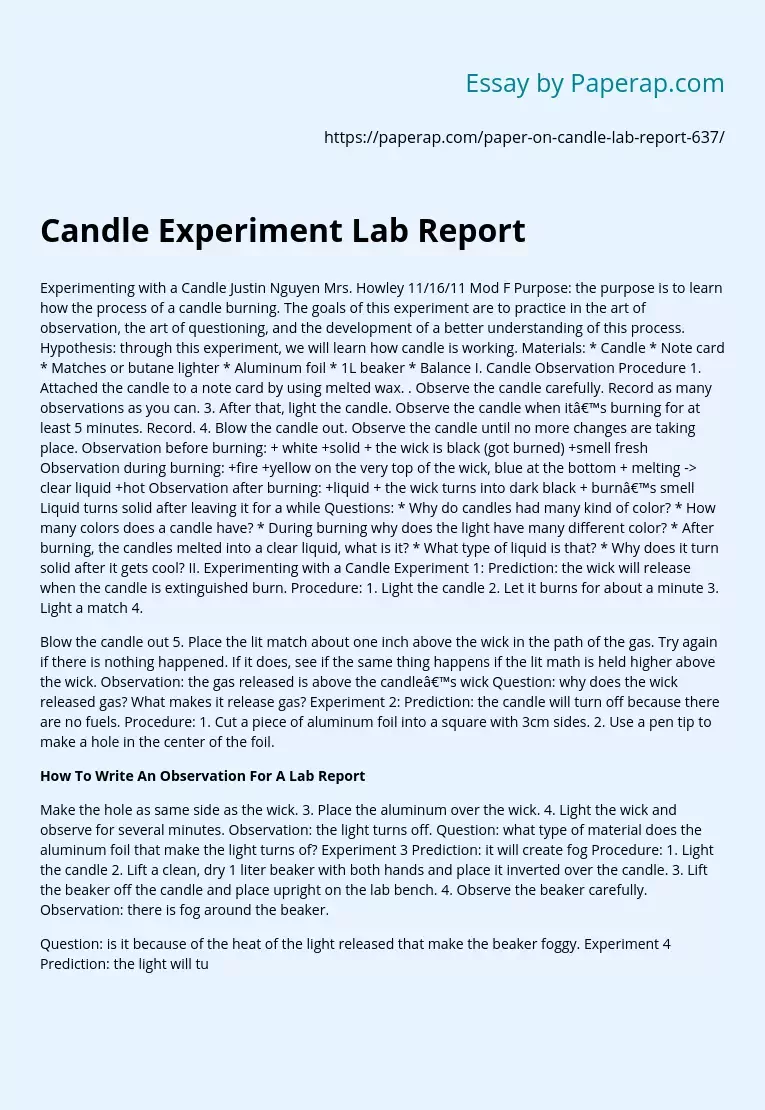Experimenting with a Candle
Experimenting with a Candle Justin Nguyen Mrs. Howley 11/16/11 Mod F Purpose: the purpose is to learn how the process of a candle burning. The goals of this experiment are to practice in the art of observation, the art of questioning, and the development of a better understanding of this process. Hypothesis: through this experiment, we will learn how candle is working. Materials: * Candle * Note card * Matches or butane lighter * Aluminum foil * 1L beaker * Balance I. Candle Observation Procedure 1. Attached the candle to a note card by using melted wax.
. Observe the candle carefully. Record as many observations as you can. 3. After that, light the candle. Observe the candle when it’s burning for at least 5 minutes. Record. 4. Blow the candle out. Observe the candle until no more changes are taking place. Observation before burning: + white +solid + the wick is black (got burned) +smell fresh Observation during burning: +fire +yellow on the very top of the wick, blue at the bottom + melting -> clear liquid +hot Observation after burning: +liquid + the wick turns into dark black + burn’s smell Liquid turns solid after leaving it for a while Questions: * Why do candles had many kind of color? * How many colors does a candle have? * During burning why does the light have many different color? * After burning, the candles melted into a clear liquid, what is it? * What type of liquid is that? * Why does it turn solid after it gets cool? II.
Experimenting with a Candle Experiment 1: Prediction: the wick will release when the candle is extinguished burn.
Procedure: 1. Light the candle 2. Let it burns for about a minute 3. Light a match 4.
Blow the candle out 5. Place the lit match about one inch above the wick in the path of the gas. Try again if there is nothing happened. If it does, see if the same thing happens if the lit math is held higher above the wick. Observation: the gas released is above the candle’s wick Question: why does the wick released gas? What makes it release gas? Experiment 2: Prediction: the candle will turn off because there are no fuels. Procedure: 1. Cut a piece of aluminum foil into a square with 3cm sides. 2. Use a pen tip to make a hole in the center of the foil.
How To Write An Observation For A Lab Report
Make the hole as same side as the wick. 3. Place the aluminum over the wick. 4. Light the wick and observe for several minutes. Observation: the light turns off. Question: what type of material does the aluminum foil that make the light turns of? Experiment 3 Prediction: it will create fog Procedure: 1. Light the candle 2. Lift a clean, dry 1 liter beaker with both hands and place it inverted over the candle. 3. Lift the beaker off the candle and place upright on the lab bench. 4. Observe the beaker carefully. Observation: there is fog around the beaker.
Question: is it because of the heat of the light released that make the beaker foggy. Experiment 4 Prediction: the light will turn off Procedure: 1. Light the candle 2. Lift a clean, dry 1 liter beaker with both hand, place it over the candle 3. Observe the beaker carefully. 4. Wait for the beaker to cool and then clean it. Observations: the light turns off while the beaker was place over the candle. Question: is it because of the oxygen that make the light turn of? Experiment 5: Prediction: the candle will get shorter while it gets burn. Procedure: 1. Determine the mass of a candle and base. . Burn for 4 minutes. 3. Determine the mass of the candle and base again. Observations: * Before burning: 18,46 g * After burning: 17. 40 g Question: while burning the candle, why didn’t the light use the oxygen as a fuels instead of using the candle? Discussions: through this experiment, I have seen and learned a lot more about the candle that they makes liquid. The candle is effect by many things around it. For example, in this experiment, without oxygen it can’t burn, or because of the aluminum foil that stop the light from getting the fuels to produce light.
Conclusion: I was able to successfully complete all of the objectives of this lab. I was surprised by the fact that candles produce liquid when they burn. Since the liquid is used to put out fires I didn’t think it could be made by one! Also, I thought the jumping flame trick was amazing. It looks like magic but I know that it isn’t. The flame just burns the flammable gas from the candle and relights the wick. I certainly understand how a candle works a lot better than I did before doing this lab. Pre- activity Questions 1. Paraffin and a wick . Paraffin is purified from crude oil, and is a petroleum product. 3. The hydrogen and carbon composition of paraffin is the reason it is a hydrocarbon. 4. Hydrogen and carbon 5. You throw it into the trash can 6. Blow the candle off Post- activity Questions 1. The wax. As the light burns the wax was melting into water 2. Gas 3. It melted into water. By observation 4. To make light. You always start to burn the light from the wick of the candle. 5. Carbon turns into CO2 6. Hydrogen turns into water 7. Hydrocarbon fuel + O2 CO2 + H2O
Experimenting with a Candle. (2019, Dec 05). Retrieved from https://paperap.com/paper-on-candle-lab-report-637/

